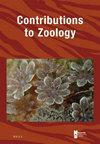Growth and limb bone histology of aetosaurs and phytosaurs from the Late Triassic Krasiejów locality (sw Poland) reveals strong environmental influence on growth pattern
IF 2.2
2区 生物学
Q1 ZOOLOGY
引用次数: 8
Abstract
The growth pattern of the Polish phytosaur Parasuchus cf. arenaceus and the aetosaur Stagonolepis olenkae (both Krasiejów; Norian) was studied. Results were compared to published data of other members of these two groups and to a new sample of the German (Heslach; Norian) phytosaur Nicrosaurus sp. All three herein studied taxa display lamellar-zonal bone consisting predominately of parallel-fibred tissue and on average a low to moderate vascular density. Towards the outer cortex the thickness of annuli increases in most samples and becomes distinctly wider than the zones. Therefore, most of the appositional growth in adults was achieved during phases of prolonged slow growth. All bones show a diffuse growth pattern, without well demarcated zones and annuli. Distinct lines of arrested growth (lag) are not identified in the Krasiejów sample, only the Nicrosaurus femur shows one distinct lag as do other taxa outside Krasiejów. Instead, the Krasiejów taxa display multiple rest lines and sub-cycles. Thus, identification and count of annual growth cycles remains difficult, the finally counted annual growth cycles range (two to six) is quite large despite the low size range of the samples. A correlation between age and bone length is not identified, indicating developmental plasticity. Although both are archosaurs, Stagonolepis and Parasuchus are phylogenetically not closely related, however, they show a very similar growth pattern, despite different life styles (terrestrial vs. semi-aquatic). Based on the new data, and previously histological studies from Krasiejów, the local environmental conditions were special and had a strong influence on the growth pattern.晚三叠世Krasiejów地区(波兰西南部)翼龙和植龙的生长和肢骨组织学揭示了环境对生长模式的强烈影响
波兰植物龙(Parasuchus cf. arenaceus)和主龙(Stagonolepis olenkae)的生长模式(均为Krasiejów;诺里安)进行了研究。结果与这两组其他成员的公开数据以及德国人(Heslach;本文所研究的三个分类群均显示板状-带状骨,主要由平行纤维组织组成,平均维管密度低至中等。在大多数样品中,向外层皮层方向,环空的厚度增加,明显比区域宽。因此,大多数成虫的对位生长是在长时间缓慢生长的阶段实现的。所有骨骼呈弥漫性生长模式,没有明确划分的区域和环空。在Krasiejów样本中没有发现明显的生长停滞(滞后)线,只有股骨尼科龙和Krasiejów以外的其他分类群显示出明显的滞后。相反,Krasiejów分类群显示多个休息行和子循环。因此,年生长周期的识别和计数仍然是困难的,尽管样本的大小范围很小,但最终计数的年生长周期范围(2到6个)相当大。年龄和骨长之间的相关性尚未确定,这表明发育可塑性。虽然两者都是始祖龙,但Stagonolepis和副龙在系统发育上并不密切相关,然而,它们表现出非常相似的生长模式,尽管它们的生活方式不同(陆地与半水生)。根据新的数据和先前来自Krasiejów的组织学研究,当地的环境条件是特殊的,对生长模式有很强的影响。
本文章由计算机程序翻译,如有差异,请以英文原文为准。
求助全文
约1分钟内获得全文
求助全文
来源期刊

Contributions to Zoology
生物-动物学
CiteScore
4.00
自引率
4.50%
发文量
16
审稿时长
>12 weeks
期刊介绍:
Contributions to Zoology solicits high-quality papers in all systematics-related branches of comparative zoology (including paleozoology). Preference will be given to manuscripts dealing with conceptual issues and to integrative papers (e.g., ecology and biodiversity, morphology and phylogeny and character state evolution, phylogeny and historical biogeography, systematics and bioinformatics, bioinformatics and biodiversity, habitat disturbance and biogeography, etc.). Reviews and alpha-taxonomic contributions are considered for publication, but acceptance will depend on their high quality and exceptional nature.
 求助内容:
求助内容: 应助结果提醒方式:
应助结果提醒方式:


